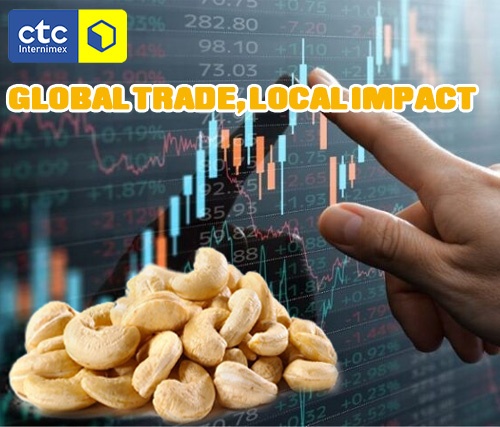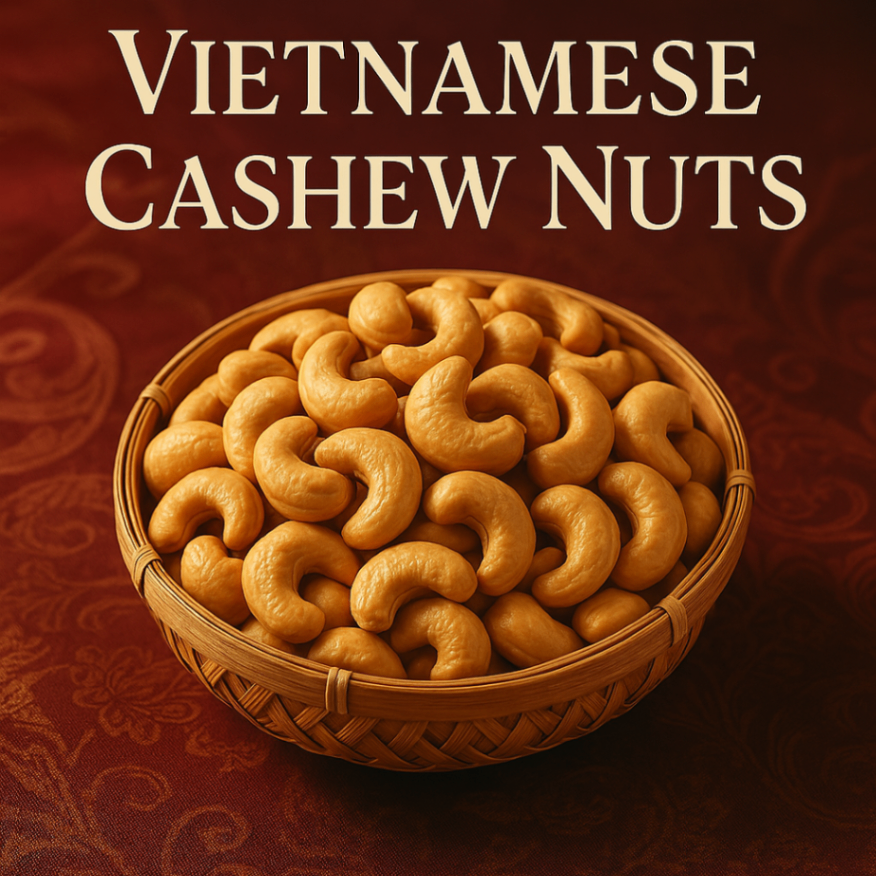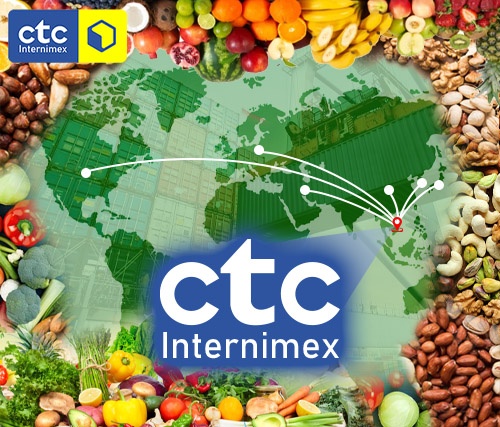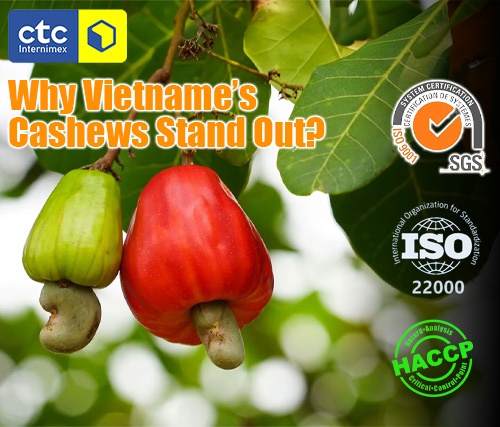- No. 2 Street 623D, Phuoc Long B Ward, Thu Duc City, HCMC, Vietnam
- Admin@CTCinternimex.com
Why Do Cashew Prices Vary On A Monthly Basis?
Cashew nuts are not merely an agricultural commodity; they are a globally traded product, with Vietnam playing a pivotal role in the supply chain. The monthly fluctuations in cashew prices are not random; they are the result of a complex interplay between supply and demand dynamics, production conditions, macroeconomic policies, and market movements. A thorough understanding of these factors is essential for producers, processors, exporters, importers, and even consumers.
1. Impact of Agricultural Production Cycles and Harvest Seasons
Like other agricultural crops, cashew trees follow a distinct growth and harvest cycle. This is the most fundamental factor shaping supply and, consequently, prices.
- Peak Harvest Season: In Vietnam, the raw cashew harvesting season typically peaks from around February to May. During this period, an abundant supply of raw cashews floods the market, exerting downward pressure on raw material prices. This allows processing factories to operate at high capacity, and the prices of finished products tend to be stable or slightly lower.
- Off-Season Periods: Once the harvest season concludes, domestic supply gradually dwindles. Processing enterprises must rely on existing inventory or import raw cashews from other markets, particularly West African countries. This reliance on imported supply, coupled with shipping costs and exchange rate risks, drives up raw material prices, directly impacting the cost of finished cashew products. The imbalance between supply and demand during these months is a primary cause of price increases.
2. Influence of Climatic Conditions and Natural Disasters
Agriculture is highly dependent on natural conditions, and cashews are no exception. Climate change is increasingly exacerbating this instability.
- Favorable Weather: A season with appropriate rainfall and stable, moderate temperatures during the flowering and fruiting stages ensures high yields and good quality nuts. This maintains a steady supply and helps control prices.
- Challenges from Natural Disasters: Prolonged droughts, floods, storms, or even unusual temperature shifts can severely damage cashew orchards, significantly reducing output. When supply is affected by natural disasters in major cashew-producing regions (such as Vietnam, Ivory Coast, India), the global supply tightens, leading to a surge in prices. Such shortages can persist for several months, impacting the global supply chain.
3. Market Demand Dynamics and Global Consumption Trends
Market demand reflects the appeal and consumption volume of cashews, directly influencing prices.
- Seasonal and Holiday Demand: Major holidays such as Lunar New Year (in Asia), Christmas, and Thanksgiving (in Western countries) typically see a significant surge in cashew demand. Importers and distributors will increase their orders in anticipation of these seasons, pushing prices higher.
- Health and Culinary Trends: The global demand for healthy, plant-based foods is steadily rising. Cashews, with their high nutritional content, have become a preferred choice for consumers. The development of processed cashew products (cashew milk, cashew butter, cashew-based vegan cheese) also expands the market and sustains high demand.
- Macroeconomic Fluctuations: The purchasing power of consumers in major import markets (USA, Europe, China) also affects demand. When economies are stable, cashew consumption tends to increase, and vice versa.
4. International Trade Policies and Exchange Rate Volatility
As a globally traded commodity, cashew prices are deeply influenced by trade policies and currency fluctuations.
- Export-Import Policies and Tariffs: Trade agreements, non-tariff barriers, or changes in import/export duty policies of producing and consuming nations can significantly alter the cost of bringing cashews to market. For instance, an increase in raw cashew import tariffs in Vietnam (if any) or tariffs on finished cashew products in major markets would raise the final selling price.
- Exchange Rate Fluctuations: Cashews are typically traded in US Dollars (USD). The fluctuation of the USD against the currencies of producing (VND) or importing (EUR, CNY) countries directly affects corporate profits and retail prices. A stronger USD makes imported cashews more expensive for consuming countries.
5. Production, Processing, and Logistics Costs
The total cost structure of the product is a fundamental factor determining the floor price of cashews.
- Raw Material Input Costs: The price of fertilizers, pesticides, and other agricultural inputs directly impacts cultivation costs.
- Labor Costs: Wages and benefits for workers in the cashew farming and processing industries can increase over time, especially in developing countries.
- Energy and Transportation (Logistics) Costs: Rising crude oil and fuel prices will increase the cost of transporting raw materials from farms to factories and from factories to international markets. Storage and preservation costs are also a significant component.
- Technology Investment: Investing in modern machinery and processing technology may initially increase costs, but in the long run, it can optimize processes, reduce labor costs, and enhance product quality, thereby influencing market pricing.
Monthly cashew price fluctuations are a complex phenomenon, reflecting the interplay of supply and demand, climatic conditions, trade policies, and operational costs. For those involved in the cashew industry, continuous updating of information on harvest seasons in major producing countries, monitoring weather forecasts, understanding consumption trends, and staying abreast of international trade policies are paramount. The ability to analyze and forecast these factors will help businesses make strategic decisions regarding raw material procurement, production, and pricing, thereby optimizing profits and mitigating risks in a volatile market.
Read more:
CTC International Import Export Joint Stock Company (CTC Internimex JSC) is a company specializing in the processing, production, and export of agricultural and forestry products from Vietnam to all over the world.
With nearly 20 years of experience in manufacturing and trading, we are committed to providing you with:
- The best quality products to meet all technical requirements.
- Quality assurance as per your requirements, with third-party inspections by SGS, Vinacontrol, Intertek, etc.
- The best prices.
- Optimized transportation costs and safe cargo through the use of reliable and experienced freight forwarders.
- Diverse shipping methods (EXW, FOB, CNF, CIF, DDP, etc.)
- Various payment methods (TT, L/C, etc.)
👉👉 We update the prices of various agricultural products every Monday.
You can refer to them at this link: Vietnam Agri-Exports: Weekly Price Updates
*** If you need to learn more about any specific product, please contact us right away. We are ready to assist you whenever you need us.
✨Big Promotion From Ctc Internimex Jsc For You 🌏✨
Partner With Ctc Internimex Jsc And Receive Even More Special Offers:
🍀 Free Sample
🍀 We Will Help You Get Import Tax Exemption
🍀 Oem Processing / Custom Design
🍀 Cheap Shipping👉👉 More details here: Big promotion from CTC internimex JSC for you
Contact our team of experts today for assistance with product information, competitive pricing, and logistics solutions for Vietnamese agricultural products.
Contact Information:
- Head office: No. 2 Street 623D, Phuoc Long B Ward, Thu Duc City, HCMC, Vietnam
- Hotline/WhatsApp: (+84) 944 772 339 / (+84) 393 887 377
- Email: Admin@CTCinternimex.com
- Search on Google Maps: Here
 Why Do Cashew Prices Vary On A Monthly Basis?
Why Do Cashew Prices Vary On A Monthly Basis?
Are you seeking international business partnership opportunities with unprecedented benefits? CTC Internimex JSC, your trusted partner in Vietnam, presents a special promotion designed to help you optimize costs and expand your market effectively.
Chia sẻ:













Comment